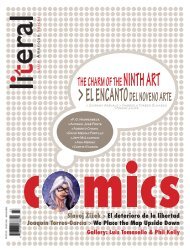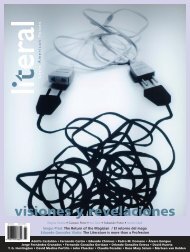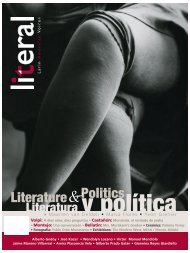Richard Serra - Literal
Richard Serra - Literal
Richard Serra - Literal
You also want an ePaper? Increase the reach of your titles
YUMPU automatically turns print PDFs into web optimized ePapers that Google loves.
La gigantomaquia ofi cial/ Offi cial Gigantomachia<br />
n Anadeli Bencomo / Interview with Carlos Monsiváis<br />
Translated to English by Tanya Huntington Hyde<br />
Anadeli Bencomo: Al abordar algunos de los temas<br />
de su libro Imágenes de la tradición viva (2006), usted<br />
se refi rió a un episodio particular de la historia del arte<br />
mexicano, el momento de la inauguración del Museo<br />
Nacional de Antropología (1964). Según nos comentaba<br />
en su charla, este museo tiene un rol protagónico<br />
en la consolidación dentro del imaginario mexicano de<br />
aquello que se entiende como patrimonio cultural de la<br />
nación. Siguiendo esta línea de refl exión, quisiera preguntarle<br />
si cree usted en la idea del “Arte Mexicano”.<br />
Carlos Monsiváis: No se puede creer en la idea<br />
del arte mexicano, simplemente porque el gentilicio<br />
no tiene mucho que hacer en estos asuntos. Lo que<br />
sí creo es en la idea de un arte hecho en México, arte<br />
hecho fuera de México por mexicanos, arte que tiene<br />
que ver sobre todo con temas mexicanos y arte que<br />
una comunidad adopta como suyo por la temática, por<br />
la costumbre, o por la afi ción a lo que consideran les<br />
pertenece; pero arte mexicano no creo que exista pues<br />
sería como si las manos de la esencia pintaran, grabaran,<br />
dibujaran… Creo que lo que se vive, y muy fuertemente,<br />
es el modo en que la costumbre se transforma<br />
en sentimiento nacional en la manera de observar el<br />
arte.<br />
AB: ¿Y dentro de esta transformación, qué rol juegan<br />
las políticas culturales?<br />
CM: Juegan un rol defi nitivo. Por ejemplo, la importancia<br />
del muralismo estaba ya presente en la década<br />
de 1920 en los pleitos que provocaban sus artistas,<br />
en el rechazo que les tenían los conservadores; pero<br />
en el momento en que comienzan las grandes exposiciones<br />
internacionales, y cuando se inicia la idea de<br />
que Rivera, Siqueiros, Orozco, Tamayo, representan a<br />
México, en ese instante hay un cambio. La comunidad<br />
nacional (o como se le quiera llamar) descubre que le<br />
gustan estos artistas porque son mexicanos, no porque<br />
les guste necesariamente lo que pintan, y de tanto que<br />
les gusta lo que hacen porque son mexicanos, acaban<br />
aceptando que les gusta porque es arte, pero eso ya es<br />
20 4 L ITERAL. LATIN AMERICAN VOICES • FALL, 2007<br />
Anadeli Bencomo: While discussing some of the<br />
themes of your book, Imágenes de la tradición viva<br />
(Images from a Living Tradition, 2006), you referred<br />
to a specifi c episode in the history of Mexican art: the<br />
inauguration of National Museum of Anthropology<br />
(1964). As you mentioned during your talk, this museum<br />
played a leading role in terms of Mexican imagery<br />
by consolidating what is considered to be the<br />
nation’s cultural patrimony. Following this same train<br />
of thought, I’d like to ask you if you believe in the concept<br />
of “Mexican Art.”<br />
Carlos Monsiváis: One cannot believe in the concept<br />
of Mexican art, because in such matters simply<br />
being genteel isn’t highly relevant. What I do believe in<br />
is the concept of art made in Mexico, art made outside<br />
Mexico by Mexicans, art that above all has to do with<br />
Mexican themes, and art that a community adopts as<br />
its own because of its subject matter, or out of custom,<br />
or out of an attachment to something that they believe<br />
belongs to them. But I don’t believe Mexican art exists,<br />
because it would be as if the hands of an essence<br />
could paint, print, or draw... I believe that what you<br />
experience, and how, is what transforms custom into<br />
national sentiment in terms of how art is seen.<br />
AB: And what role do cultural policies play within<br />
this transformation?<br />
CM: They play a defi nitive role. For example, the<br />
presence of muralism was felt as early as the 1920s<br />
through confl icts generated by its artists, and the way<br />
they were rejected by the conservatives. But right when<br />
the big international exhibitions began, when the idea<br />
that Rivera, Siqueiros, Orozco, Tamayo represented<br />
Mexico came about, at that moment, there’s a change.<br />
The national community (or whatever you want to call<br />
it) discovers that it likes these artists not necessarily because<br />
they like what they’re painting, but because they<br />
are Mexican. And from so much liking what they do<br />
because they’re Mexican, they wind up accepting that<br />
they like it because it’s art, but this is already a longer<br />
Sin las políticas culturales del gobierno del PRI, mucho de lo que ahora se ha establecido no tendría<br />
lugar. Una gran ventaja de los gobiernos del Partido de Acción Nacional (PAN) es que no entienden<br />
nada de arte, no les interesa en lo más mínimo y, por tanto, no van a imponer ninguna línea...






